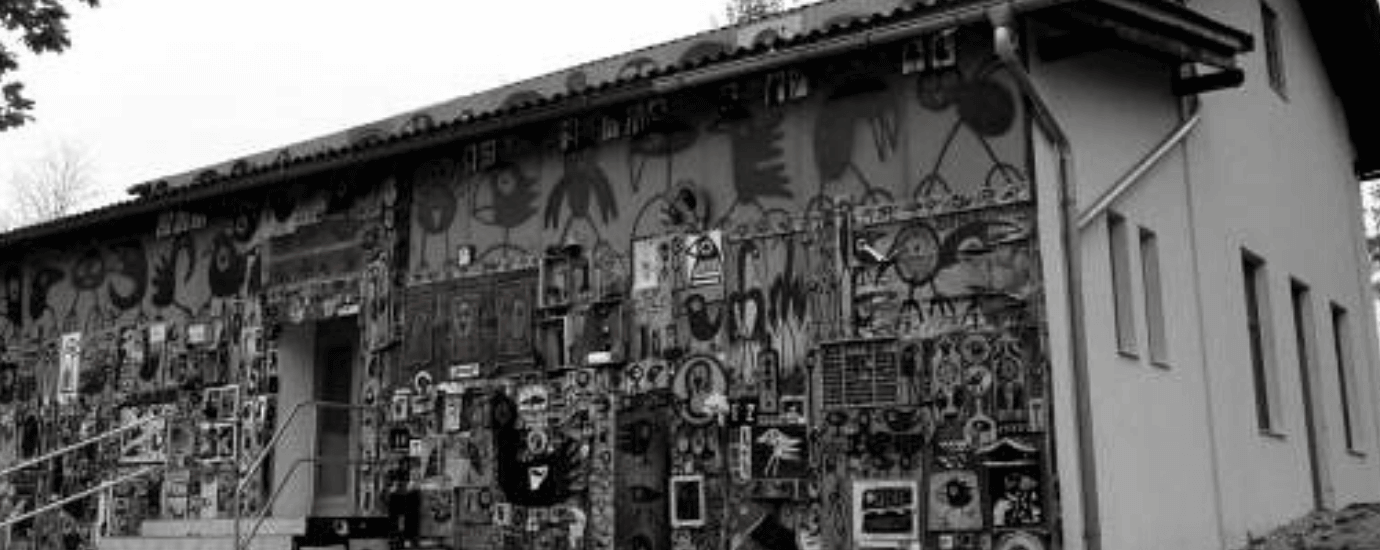« ART IS ALWAYS WHERE IT IS NOT EXPECTED »
In 1949, Jean Dubuffet, plastic artist, triggered an earthquake in the academic world of Art.
His exhibition in the Drouin Gallery in Paris is a collection of artworks that no-one ever dared to called 'art’.
Affected for decades by the work of non professional artists working outside the aesthetics norms, out of the artistic community, or suffering from the lack of social ties with a psychological impact so strong that they became isolated and started to create, Dubuffet created this exhibition marking the starting point and the founding act of Art Brut.
His exhibition in the Drouin Gallery in Paris is a collection of artworks that no-one ever dared to called 'art’.
Affected for decades by the work of non professional artists working outside the aesthetics norms, out of the artistic community, or suffering from the lack of social ties with a psychological impact so strong that they became isolated and started to create, Dubuffet created this exhibition marking the starting point and the founding act of Art Brut.
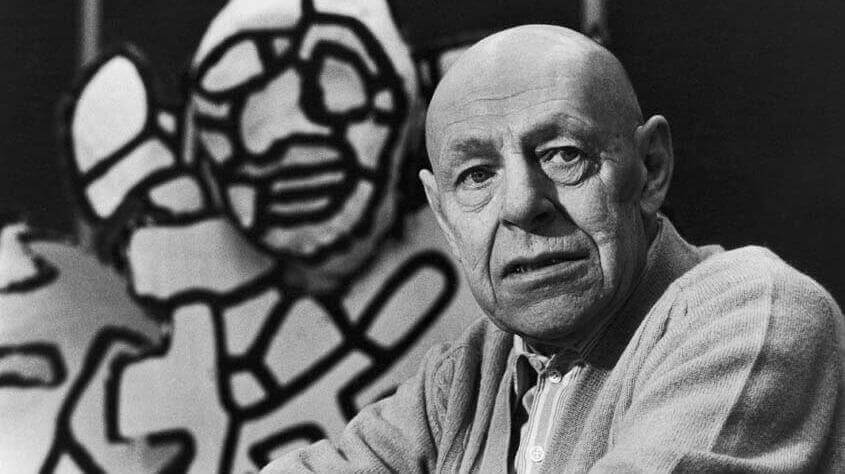
“The True Art, is where it is not expected. Where no-one thinks about it or says its name. Art hates to be recognized and acclaimed. It runs away instantly. Art is a character smitten with incognito. Once it is detected (…), it runs away leaving in its place a crowned actor carrying on its back a large sign where it is written Art, that everyone spray with champagne and that lecturer walk around from city to city with a nose-ring.”
This spontaneous art, without academism or references, is often roughly curtailed as “fool’s art”.
Proof of this is that among the exhibited artworks from Jean Dubuffet in 1949, some are immediately recognized as masterpieces.
They are signed by the head and the hands of Adolf Wölfi and Aloïse Corbaz, two Swiss psychiatric institution residents.
USELESS LIVES TO DAVID BOWIE
Hidden in the wooded hills, in a bucolic and green setting, close to Vienna, the Gugging center has combined for more than half a century psychiatry and Art with a spectacular success.
At the beginning, however, the psychiatric hospital of Gugging, has a really dark background. The first lines of its history are dramatic: during World War II, Nazis killed hundreds of patients.
Another time where Germany exterminated those with mental illness arguing that their lives were useless…
When the horror passed, in the fifties, the new director, Leo Navratil, has accidentally started to diagnose and treat his patients by encouraging them to draw or paint.
Surprised by the results, Navratil starts a correspondence with Jean Dubuffet whom finds out, through these productions, a great source for his Art Brut collection.
Mutually nurtured from this relationship, Dubuffet and the Gugging Center are developing exponentially.
In the eighties, Leo Navratil, always inspired, establish an Art Center in Gugging named the Artists House.
In the last fifty years, the patient-artists have made a surprising collection of 75 000 renowned artworks, of which some got sold for almost 100 000€.
Some of them became Art Brut celebrity such as August Walla, Oswald Tschirtner or Johann Hauser.
A shopping mall and a museum were the next steps of the project, attracting a growing number of visitors.
One of them was David Bowie, who bought several artworks for his own Art collection.
A celestial path for the modest Gugging Center which has become the Mecca of Art Brut, far from the scatterbrained considerations of the Nazis.
At the beginning, however, the psychiatric hospital of Gugging, has a really dark background. The first lines of its history are dramatic: during World War II, Nazis killed hundreds of patients.
Another time where Germany exterminated those with mental illness arguing that their lives were useless…
When the horror passed, in the fifties, the new director, Leo Navratil, has accidentally started to diagnose and treat his patients by encouraging them to draw or paint.
Surprised by the results, Navratil starts a correspondence with Jean Dubuffet whom finds out, through these productions, a great source for his Art Brut collection.
Mutually nurtured from this relationship, Dubuffet and the Gugging Center are developing exponentially.
In the eighties, Leo Navratil, always inspired, establish an Art Center in Gugging named the Artists House.
In the last fifty years, the patient-artists have made a surprising collection of 75 000 renowned artworks, of which some got sold for almost 100 000€.
Some of them became Art Brut celebrity such as August Walla, Oswald Tschirtner or Johann Hauser.
A shopping mall and a museum were the next steps of the project, attracting a growing number of visitors.
One of them was David Bowie, who bought several artworks for his own Art collection.
A celestial path for the modest Gugging Center which has become the Mecca of Art Brut, far from the scatterbrained considerations of the Nazis.
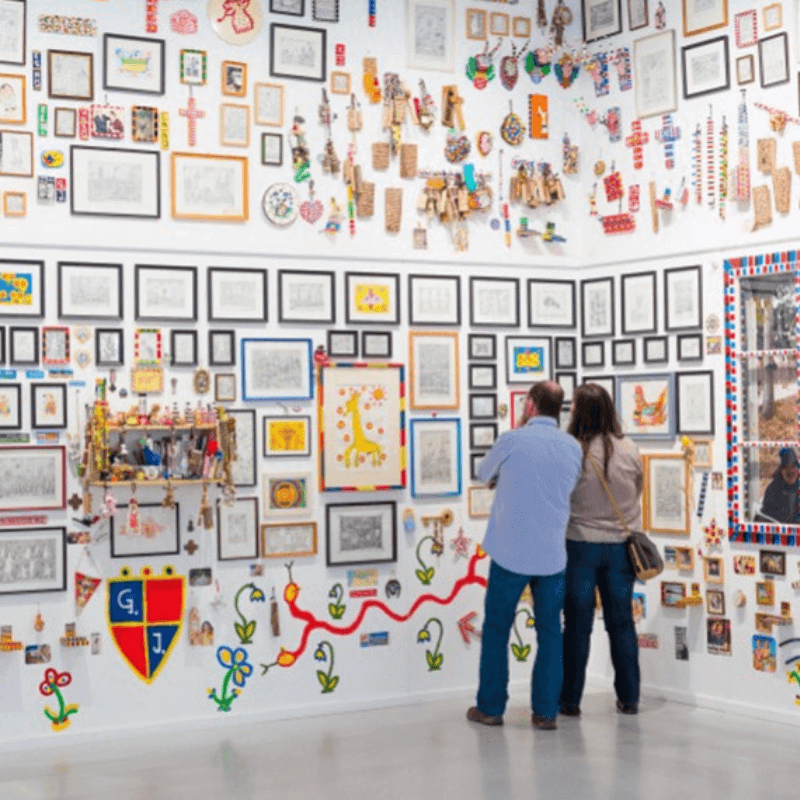
ARTISTS, NOT PATIENTS
The psychiatric clinic has been closed for several years now, but the Artists House has stayed, and the Gugging Center is not anymore a hospital.
“For us, residents are first and foremost artists with special needs, not patients” says the current director, Johann Feilacher. “
With the Creative Growth Art Center in Oakland, California, Gugging is one of the rare place in the world where that many impacting artists came out from”, notices Sarah Lombardi, Director of the Art Brut Collection.
“For us, residents are first and foremost artists with special needs, not patients” says the current director, Johann Feilacher. “
With the Creative Growth Art Center in Oakland, California, Gugging is one of the rare place in the world where that many impacting artists came out from”, notices Sarah Lombardi, Director of the Art Brut Collection.
The secret?
“A good mental monitoring and great working conditions” confide Feilacher who is also artist and psychiatrist.
Today, they are 15, aged from 23 to 81, as Alfred Neumayr and Karl Vondal to elaborate productions in a large workshop looking over the surrounding hills “but they’re not all artists per se. What they produce must be specific to be recognized as art. Some find themselves belatedly, others never”.
Afterall, it doesn’t matter, satisfying reasons are numerous, equally for artists as Johann Garber, 70 says “I love to share my Art. I am happy to draw. Here we are great painters and illustrators, and we are happy to have a place where we can live and paint” than for the Art Brut in general, fully renowned.
“ Art Brut has nothing of a secret or romantic, it neither better nor inferior as other art forms. The important thing is the artworks quality, whoever is the author” Thinks Sarah Lombardi.
Today, they are 15, aged from 23 to 81, as Alfred Neumayr and Karl Vondal to elaborate productions in a large workshop looking over the surrounding hills “but they’re not all artists per se. What they produce must be specific to be recognized as art. Some find themselves belatedly, others never”.
Afterall, it doesn’t matter, satisfying reasons are numerous, equally for artists as Johann Garber, 70 says “I love to share my Art. I am happy to draw. Here we are great painters and illustrators, and we are happy to have a place where we can live and paint” than for the Art Brut in general, fully renowned.
“ Art Brut has nothing of a secret or romantic, it neither better nor inferior as other art forms. The important thing is the artworks quality, whoever is the author” Thinks Sarah Lombardi.
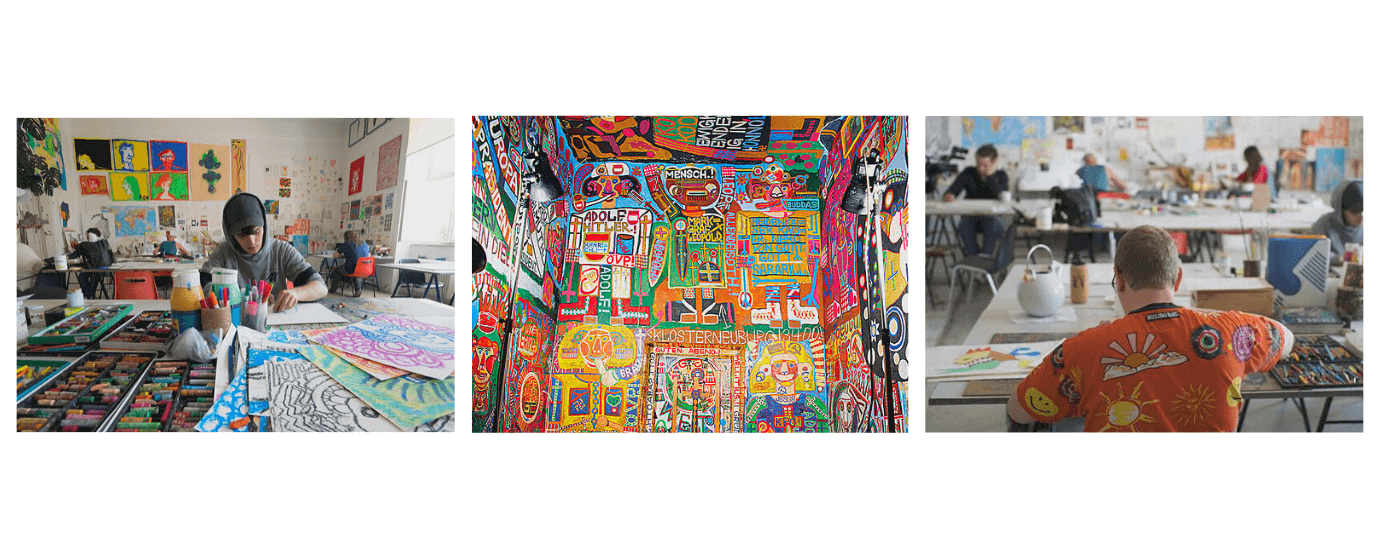
“ Art Brut from yesterday and today” (Art Brut gestern und heute) is the 2017 year theme.
Since January 26, the Gugging Museum shows the “Jean Dubuffet’s Art Brut! The starts of his collection” exhibition.
An exhibition dedicated to the Art Brut origins and showing famous or unknown productions from the Dubuffet collection.
Starting next July 19, Art Brut news will be on the stage : the two artists from Gugging Johann Garber and Karl Vondal change the museum into their workshop, inviting the visitors to look at their artworks and watch them paint.
Finally, pieces of art from Gugging artists are also exhibited until june 11 in the “Psycho Drawing” exhibit in the Lentos de Linz museum.
A great highlight for an Art and artists, proving no matter how tortured, insane or particular, a life is never useless.
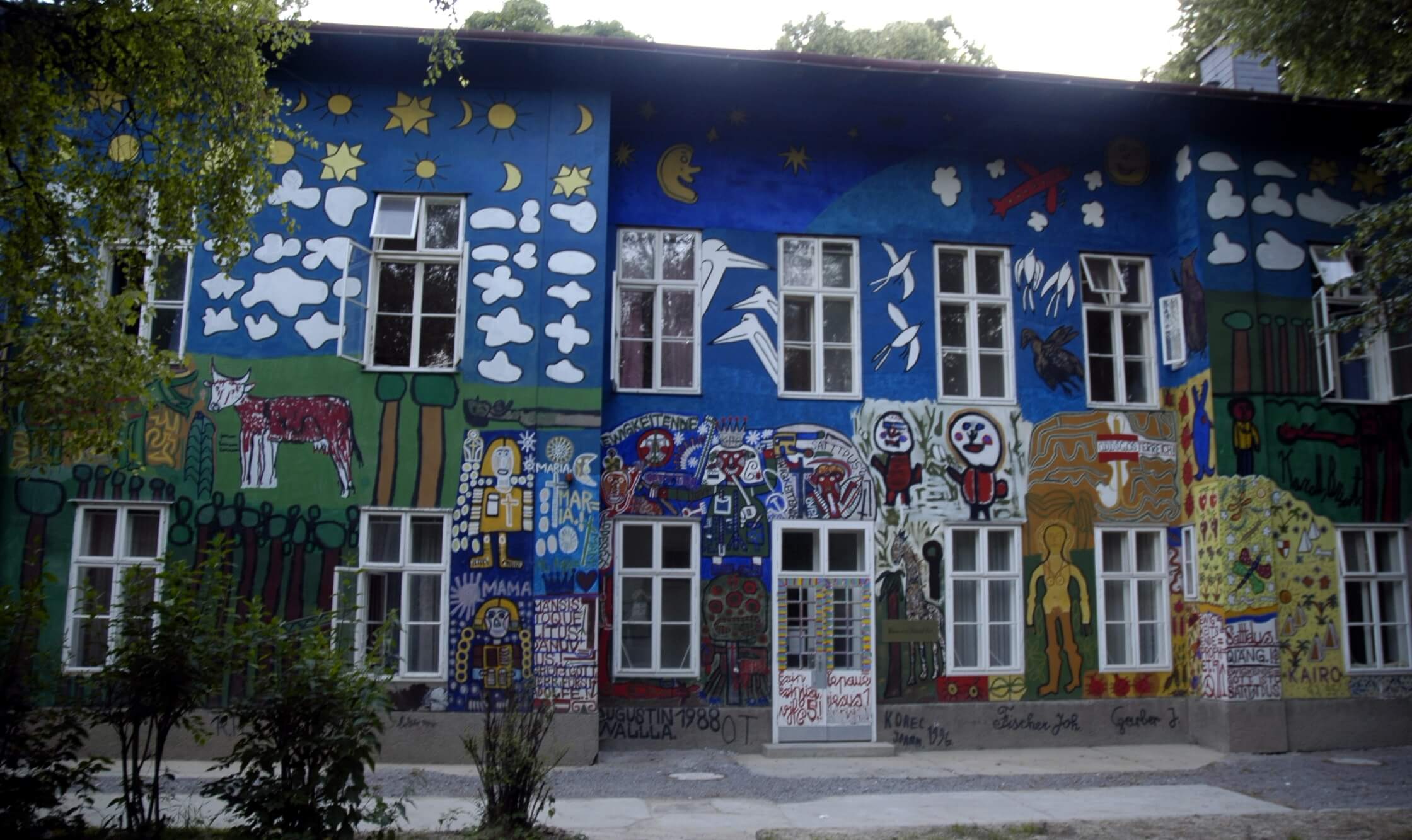
ALEX'N, READY FOR THE ART BRUT
Coming from the Cevennes, Alex’n has always been immersed in an artistic atmosphere.
After looking for her own style and path for a long time, she finds her influence in the street art and singular Art.
She finds and echo in those artistic movement to her imagination and her desire to express her emotions.
Alex’n first works on her technique and on all styles before feeling ready for Art Brut.
In 2002, she imagines “Pebbles men” : stylized characters with square heads.
She would like to create a character and make him evolve with time.
She invents families, clumsy animals that will allow her to tell stories from the everyday life with humor and poetry.
Human characters are easy to identify to.
Animal scenes push humor to the point of absurdity.
Beyond the stories, Alex’n work shows attention to material and colors.
After looking for her own style and path for a long time, she finds her influence in the street art and singular Art.
She finds and echo in those artistic movement to her imagination and her desire to express her emotions.
Alex’n first works on her technique and on all styles before feeling ready for Art Brut.
In 2002, she imagines “Pebbles men” : stylized characters with square heads.
She would like to create a character and make him evolve with time.
She invents families, clumsy animals that will allow her to tell stories from the everyday life with humor and poetry.
Human characters are easy to identify to.
Animal scenes push humor to the point of absurdity.
Beyond the stories, Alex’n work shows attention to material and colors.


